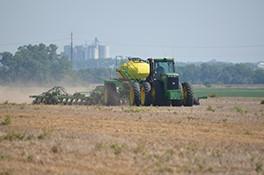Adam Baldwin, who farms in central Kansas, said although he hasn’t planted his grain sorghum yet, he’s looking forward to a successful growing season thanks to much needed moisture that he received late in the spring.
“We’re set up to have a really good crop this year,� he said. “Although we’re getting in the field later than we planned, planting later is typically better for the crop.�
While cool, wet weather in Baldwin’s part of the state kept him from getting into the field as early as he’d planned, there’s still plenty of time to get the crop in the ground, Baldwin said. According to Kansas State University, a successful crop can be planted from early May through late June, depending upon location within the state and local conditions.
“As long as we have the crop planted by July 4, we’ll have plenty of growing season left,� Baldwin said.
Late June U.S. Department of Agriculture (USDA) reports show 90 percent of sorghum in Kansas is planted. This is down just 4 percent from the average for 2010-2014, and the difference is due, in part, to heavy rainfall in some areas of the state. Much of the U.S. Sorghum Belt experienced heavy rains late in the spring, pushing back planting dates on many farms.
In addition to weather conditions, weeds and grass are other threats to the health of the crop during the growing season. Baldwin takes steps to minimize these issues by not planting the same crop on the same piece of land every year to keep fields clean. Following emergence of the grain, crop consultants scout Baldwin’s fields. They utilize chlorophyll meters to measure the green pigment in plants used for photosynthesis and nitrogen rich strips to determine nitrogen needs within a particular field.
Baldwin is looking forward to a strong market at harvest this fall. Sorghum production in the United States is seeing significant growth due to increased demand from the international market. USDA estimates this year’s planted acres will reach 7.9 million acres (3.2 million hectares), an increase of 11 percent from the previous season.


